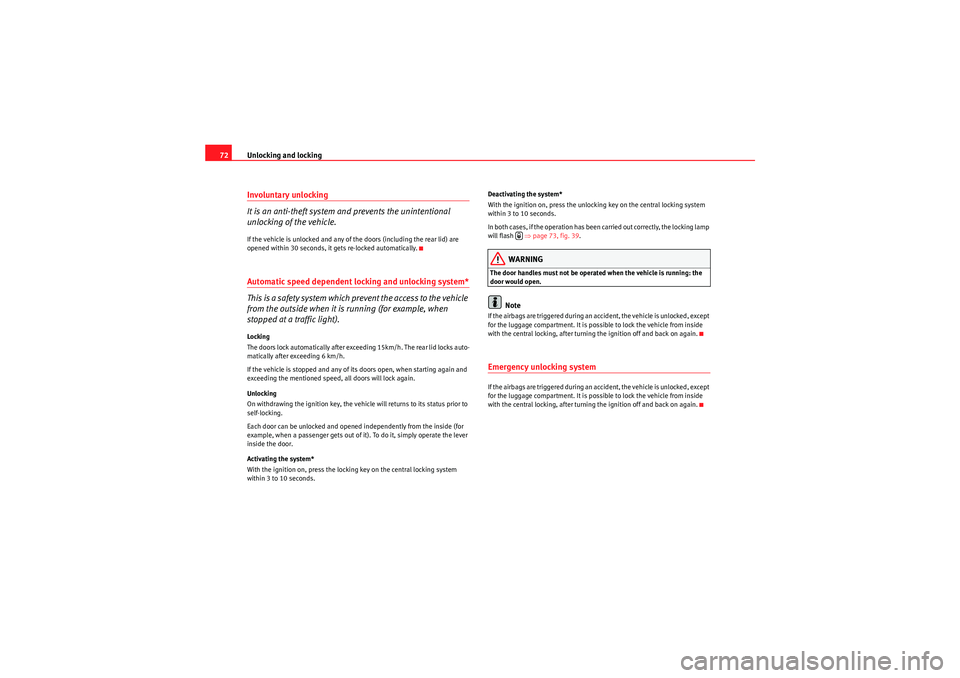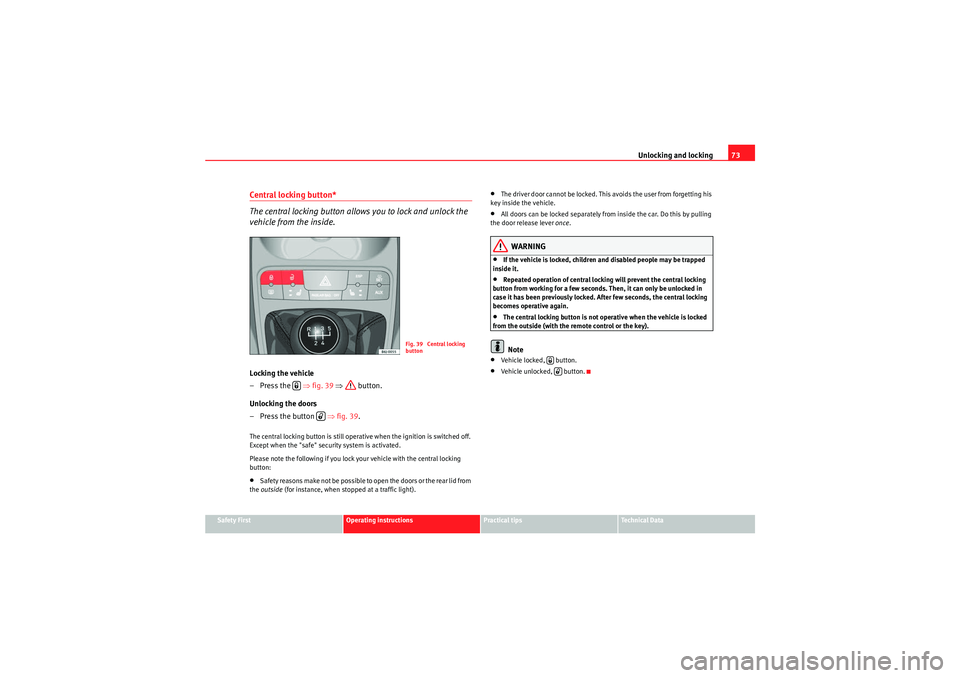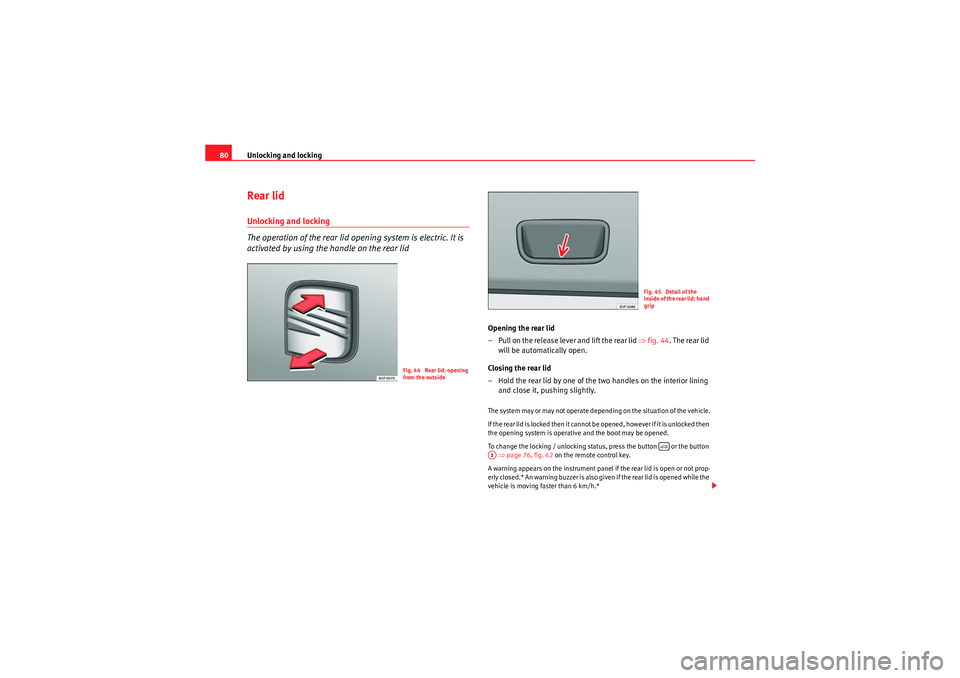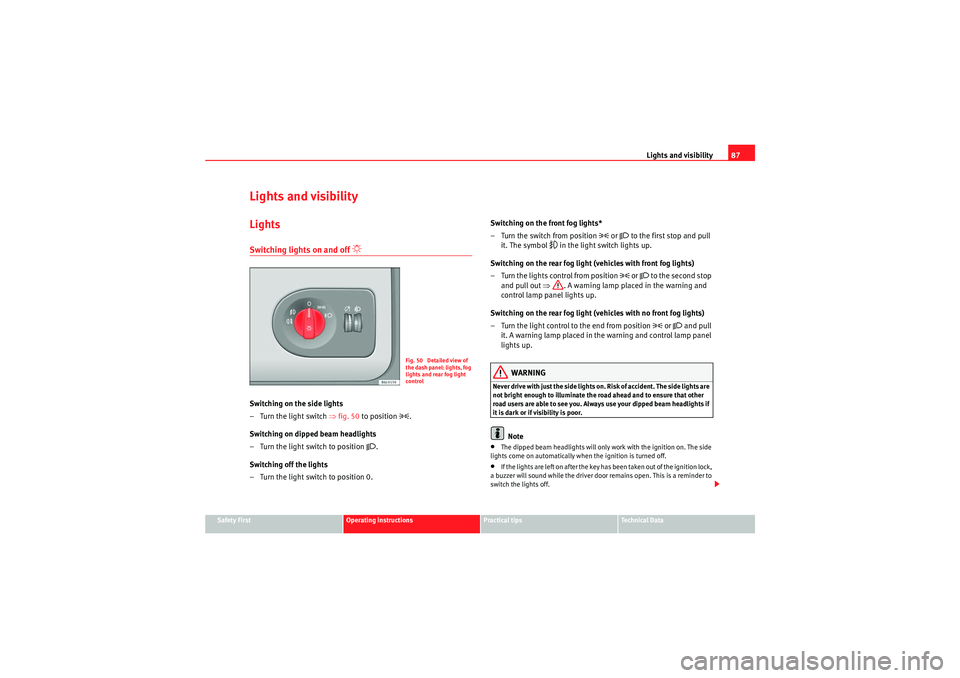2009 Seat Ibiza ST Light
[x] Cancel search: LightPage 71 of 250

Unlocking and locking
70Unlocking and lockingCentral l ocking Description
The central locking system enables you to lock and unlock all
doors by just pushing the button.Central locking can be activated by using any of the following options:•the key , by inserting it into the driver door cylinder and rotating it in the
opening direction. Depending on the vehicle version, either all doors will be
unlocked or only the driver door will be unlocked. All doors will be locked on
locking the vehicle using the key.•the interior central locking button ⇒ page 73.•the radio frequency remote control , using the buttons on the key
⇒ page 76.
Various functions are available to improve the vehicle safety:
- “Safe*” security system
- Selective unlocking system*
- Self-locking system to prevent involuntary unlocking
- Automatic speed-dependent locking and unlocking system*
- Emergency unlocking systemWARNING
•Locking from the outside carelessly or without good visibility may lead
to bruising, particularly in the case of children.•When locking a vehicle, never leave children unaccompanied inside, as
from the outside it will be difficult to provide assistance if required.
•Having the doors locked prevents an intrusion from getting in, for
example when stopped at a traffic light.Note
For anti-theft security, only the driver door is fitted with a lock cylinder.“Safe”* Security system
This is an anti-theft device that consists of a double lock for
the door locks and a disabling function for the luggage
compartment in order to prevent a forced entry (depending
on country).Activation
The “safe” system is activated when the vehicle is locked using the key or the
remote control.
To activate it with the key, rotate once it is inserted in the door lock cylinder
in the locking direction.
To activate the system using the remote control, press the lock button once on the remote.
Once this system is activated, opening doors from the outside and the inside
is not possible. The rear lid can not be opened. The central locking button
does not work.
WARNING (continued)
Ibiza ST_EN.book Seite 70 Dienstag, 12. Januar 2010 4:03 16
Page 73 of 250

Unlocking and locking
72Involuntary unlocking
It is an anti-theft system and prevents the unintentional
unlocking of the vehicle.If the vehicle is unlocked and any of the doors (including the rear lid) are
opened within 30 seconds, it gets re-locked automatically.Automatic speed dependent locking and unlocking system*
This is a safety system which prevent the access to the vehicle
from the outside when it is running (for example, when
stopped at a traffic light).Locking
The doors lock automatically after exceeding 15km/h. The rear lid locks auto-
matically after exceeding 6 km/h.
If the vehicle is stopped and any of its doors open, when starting again and
exceeding the mentioned speed, all doors will lock again.
Unlocking
On withdrawing the ignition key, the vehicle will returns to its status prior to
self-locking.
Each door can be unlocked and opened independently from the inside (for
example, when a passenger gets out of it). To do it, simply operate the lever
inside the door.
Activating the system*
With the ignition on, press the locking key on the central locking system
within 3 to 10 seconds. Deactivating the system*
With the ignition on, press the unlocking key on the central locking system
within 3 to 10 seconds.
In both cases, if the operation has been carried out correctly, the locking lamp
will flash ⇒
page 73, fig. 39 .
WARNING
The door handles must not be operated when the vehicle is running: the
door would open.
Note
If the airbags are triggered during an accident, the vehicle is unlocked, except
for the luggage compartment. It is possible to lock the vehicle from inside
with the central locking, after turning the ignition off and back on again.Emergency unlocking systemIf the airbags are triggered during an accident, the vehicle is unlocked, except
for the luggage compartment. It is possible to lock the vehicle from inside
with the central locking, after turning the ignition off and back on again.
Ibiza ST_EN.book Seite 72 Dienstag, 12. Januar 2010 4:03 16
Page 74 of 250

Unlocking and locking73
Safety First
Operating instructions
Practical tips
Technical Data
Central locking button*
The central locking button allows you to lock and unlock the
vehicle from the inside.Locking the vehicle
–Press the ⇒fig. 39 ⇒ button.
Unlocking the doors
– Press the button ⇒fig. 39 .The central locking button is still operative when the ignition is switched off.
Except when the "safe" security system is activated.
Please note the following if you lock your vehicle with the central locking
button:•Safety reasons make not be possible to open the doors or the rear lid from
the outside (for instance, when stopped at a traffic light).
•The driver door cannot be locked. This avoids the user from forgetting his
key inside the vehicle.•All doors can be locked separately from inside the car. Do this by pulling
the door release lever once.WARNING
•If the vehicle is locked, children and disabled people may be trapped
inside it.•Repeated operation of central locking will prevent the central locking
button from working for a few seconds. Then, it can only be unlocked in
case it has been previously locked. After few seconds, the central locking
becomes operative again.•The central locking button is not operative when the vehicle is locked
from the outside (with the remote control or the key).Note
•Vehicle locked, button.•Vehicle unlocked, button.
Fig. 39 Central locking
button
Ibiza ST_EN.book Seite 73 Dienstag, 12. Januar 2010 4:03 16
Page 79 of 250

Unlocking and locking
78Anti-theft alarm system*Description of anti-theft alarm system*
The anti-theft alarm triggers if unauthorised movements are
detected around the vehicle.The anti-theft alarm makes it more difficult to break into the vehicle or steal
it. The system will initiate acoustic and optical warning signals when your
vehicle is tried to be forced.
The anti-theft alarm system is automatically connected on locking the
vehicle. For this, either rotate the key in the locking position or press button
on the radio-frequency remote control*. The system is immediately
activated and the turn signal light located on the driver door will flash along
with the turn signals, indicating that the alarm and the locking security
system (double lock) have been turned on.
If any of the doors or the bonnet are open, they will not be included in the
protection zones of the vehicle when the alarm is connected. If the door or the
bonnet are subsequently closed, they will be automatically included in the
protection areas of the vehicle and the turn signals will flash accordingly
when the doors close.•The turn signal light will flash twice on opening and deactivating the
alarm..•The turn signal light will flash once on closing and activating the alarm.
When does the system trigger an alarm?
The system triggers an alarm if the following unauthorised actions are carried
out when the car is locked:•Opening of vehicle with mechanical key without switching ignition on
within the next 15 seconds•Opening a door
•Opening the bonnet•Opening the rear lid•Ignition switched on with a non-validated key.•Movements in the driving compartment (vehicles with a volume sensor)•Towi ng of t he ve hi cle
7)
•Tilt angle (tow-away protection)
7)
•Undue manipulation of the alarm•Battery handling
The acoustic signals sound and the turn signals flash for approx. 30 seconds.
This may be repeated up to 10 times depending on the country.
How to switch the alarm off
To deactivate the anti-theft alarm, turn the key in the direction, to open, open
the door and switch the ignition on, or press the unlock button on the
remote control.
In ve hicles eq ui ppe d wit h an a nti -t he f t a lar m s yste m , you have 1 5 s e co nds to
insert the key in the ignition lock and activate the ignition if the vehicle is
opened using the driver door key.
Otherwise, the alarm will trigger for 30 sec. and the ignition will be blocked.Note
•After 28 days, the indicator light will be switched off to prevent the battery
from exhausting if the vehicle has been left parked for a long period of time.
The alarm system remains activated.•The alarm will trigger again if attempts are made to open another protec-
tion zone.•The alarm system can be activated or deactivated using the remote
control ⇒page 76.
A2
7)With vehicles fitted with a tow-away protection
Ibiza ST_EN.book Seite 78 Dienstag, 12. Januar 2010 4:03 16
Page 81 of 250

Unlocking and locking
80Rear lidUnlocking and locking
The operation of the rear lid opening system is electric. It is
activated by using the handle on the rear lid
Opening the rear lid
– Pull on the release lever and lift the rear lid ⇒fig. 44 . The rear lid
will be automatically open.
Closing the rear lid
– Hold the rear lid by one of the two handles on the interior lining and close it, pushing slightly.The system may or may not operate depending on the situation of the vehicle.
I f t h e r e a r l i d is l o cke d t h e n i t ca n n o t b e o p e n e d , h o w e v e r i f i t is u nl o cke d t h e n
the opening system is operative and the boot may be opened.
To change the locking / unlocking status, press the button or the button
⇒ page 76, fig. 42 on the remote control key.
A warning appears on the instrument panel if the rear lid is open or not prop-
e r l y c l o s e d . * A n wa r n i n g b u z ze r is a l s o g i v e n i f t h e r e a r l i d i s o p e n e d w h i l e t h e
vehicle is moving faster than 6 km/h.*
Fig. 44 Rear lid: opening
from the outside
Fig. 45 Detail of the
inside of the rear lid: hand
grip
A1
Ibiza ST_EN.book Seite 80 Dienstag, 12. Januar 2010 4:03 16
Page 82 of 250

Unlocking and locking81
Safety First
Operating instructions
Practical tips
Technical Data
WARNING
•Always close the rear lid properly. Risk of accident or injury.•The rear lid must not be opened when the reverse or rear fog lights are
lit. This may damage the tail lights•Do not close the rear lid by pushing it down with your hand on the rear
window. The glass could smash. Risk of injury!•Ensure the rear lid is locked after closing it. If not, it may open unex-
pectedly while driving.•Never allow children to play in or around the vehicle. A locked vehicle
can be subjected to extremely high and low temperatures, depending on
the time of year, thus causing serious injuries/illness. It could even have
fatal consequences. Close and lock both the rear lid and all the other doors
when you are not using the vehicle.•Closing the rear lid without observing and ensuring it is clear could
cause serious injur y to you and to third parties. Make sure that no one is in
the path of the rear lid.•Never drive with the rear lid open or half-closed, exhaust gases may
penetrate into the interior of the vehicle. Danger of poisoning!•If you only open the rear lid, do not leave the key inside. The vehicle will
not be opened if the key is left inside.
Emergency opening
This allows the vehicle to be opened if the central locking
does not operate (for exampl e, if the battery is flat)There is a groove in the luggage compartment allowing access to the
emergency opening mechanism.
Opening the rear lid from inside the luggage compartment
– Insert the key in the groove and unlock the locking system,
turning the key from right to left, as shown by the arrow
⇒fig. 46 .
Fig. 46 Rear lid: emer-
gency open
Ibiza ST_EN.book Seite 81 Dienstag, 12. Januar 2010 4:03 16
Page 88 of 250

Lights and visibility87
Safety First
Operating instructions
Practical tips
Technical Data
Lights and visibilityLightsSwitching lights on and off
Switching on the side lights
– Turn the light switch ⇒fig. 50 to position
.
Switching on dipped beam headlights
– Turn the light switch to position
.
Switching off the lights
– Turn the light switch to position 0. Switching on the front fog lights*
– Turn the switch from position
or to the first stop and pull
it. The symbol
in the light switch lights up.
Switching on the rear fog light (vehicles with front fog lights)
– Turn the lights control from position
or to the second stop
and pull out ⇒. A warning lamp placed in the warning and
control lamp panel lights up.
Switching on the rear fog light (vehicles with no front fog lights)
– Turn the light control to the end from position or and pull
it. A warning lamp placed in the warning and control lamp panel
lights up.
WARNING
Never drive with just the side lights on. Risk of accident. The side lights are
not bright enough to illuminate the road ahead and to ensure that other
road users are able to see you. Always use your dipped beam headlights if
it is dark or if visibility is poor.
Note
•The dipped beam headlights will only work with the ignition on. The side
lights come on automatically when the ignition is turned off.•If the lights are left on after the key has been taken out of the ignition lock,
a buzzer will sound while the driver door remains open. This is a reminder to
switch the lights off.
Fig. 50 Detailed view of
the dash panel: lights, fog
lights and rear fog light
control
Ibiza ST_EN.book Seite 87 Dienstag, 12. Januar 2010 4:03 16
Page 89 of 250

Lights and visibility
88•The rear fog light is so bright that it can dazzle drivers behind you. You
should use the rear fog light only when visibility is very poor.•The use of the lighting described here is subject to the relevant statutory
requirements.Instrument and switch lighting / Headlight range controlInstrument and switch lighting
When the headlights are switched on, the brightness of the instruments and
switch lighting can be regulated to suit your requirements by turning the
thumb wheel ⇒fig. 51 .
Those vehicles fitted with xenon gas discharge headlights are fitted with an
automatic headlight range system.
Headlight range control
By using the electrical headlight range control, you can adjust the head-
light range to the load level that is being carried in the vehicle. This way, it is possible to avoid dazzling oncoming traffic more than necessary. At the same
time, by using the correct headlight settings, the driver has the best possible
lighting for the road ahead.
The headlights can only be adjusted when the dipped beam is switched on.
To lower the beam, turn the thumb wheel down from the basic setting
0.
Dynamic headlight range control
Ve hi cle s wi th gas discharge bulbs (xenon bulbs) are equipped with dynamic
headlight range control . When you switch on the lights, their range regulates
itself according to the vehicle load.
Vehicles with gas discharge bulbs do not have headlight range control.
Daytime running lights*
Daytime running lights light up automatically when the igni-
tion is switched on (only with AFS headlights)Daylight driving lights switch off automatically when the street lighting
comes on.
Note
See legal requirements for each country.
Fig. 51 Dash panel: regu-
lation for instrument and
switch illumination and
headlight range control
A1
A1A2
A2
A2
Ibiza ST_EN.book Seite 88 Dienstag, 12. Januar 2010 4:03 16